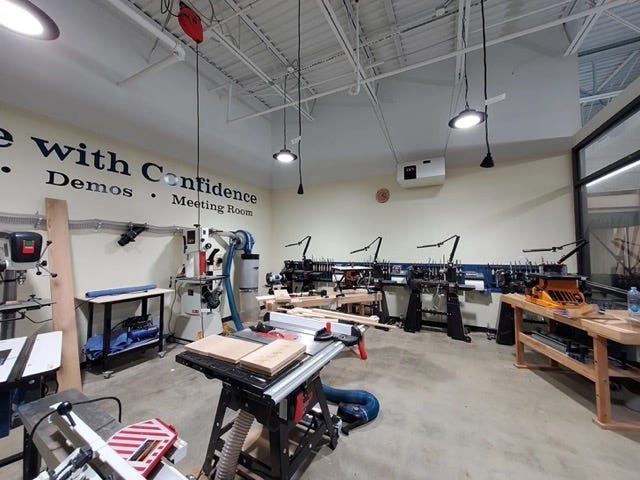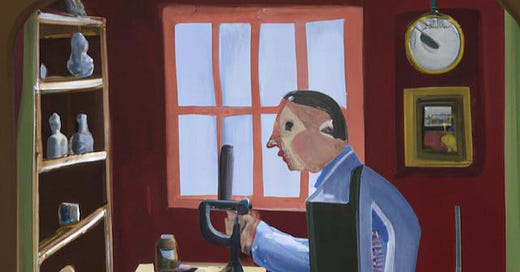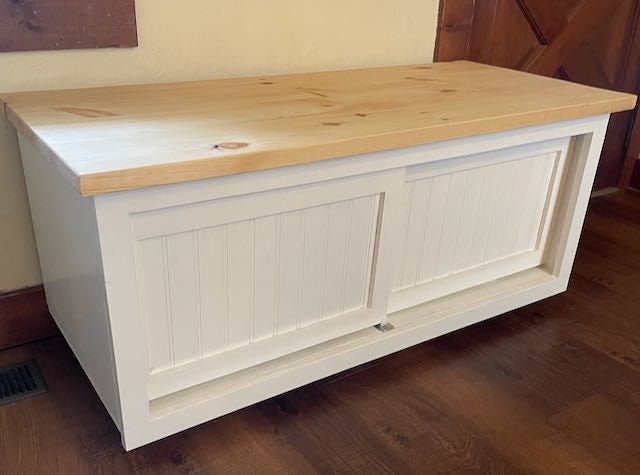Welcome to the Quarantine Creatives newsletter, a companion to my podcast of the same name, which explores creativity, art, and big ideas as we continue to live through this pandemic.
Every Wednesday, I share random thoughts and tidbits with links to let you do some exploring. I call these Wednesday Walks, as it’s the type of conversation we might have walking down a path in the woods- the topics are free flowing, sometimes related, sometimes not.
If you like what you’re reading and want to support this publication, please consider a free subscription to have this newsletter delivered to your inbox:
Even though many of us are spending this week putting away our holiday decorations, I had one last Christmas story to discuss.
Just One Word: Christmas Trees
One of my strongest memories from my early days at Ask This Old House was a shoot we did at a local Christmas tree farm. This was probably back in about 2007 and I was serving as a production assistant on the show at the time.
The conceit of the segment was that Roger Cook was going to teach the viewer how to pick out the perfect Christmas tree. When paired with farmer Bill Gauld from Evergreen Farm in Sterling, MA, the segment turned into more of a day in the life of a tree farmer.
I had grown up visiting a local tree farm in Ohio, but our visits were usually about a half an hour per year. We’d find a tree, tie it to our roof, and head home. I had no idea about the growing process, so I was wide-eyed when we were filming in Sterling to learn all about the different varieties of tree, how they grow from a seedling, and how they are shaped into the recognizable Christmas tree shape (which is not how the tree would grow in nature).
Here’s the segment if you’re interested:
This video was shot about 15 years ago and was one of hundreds (maybe even thousands) that I worked on in my time at This Old House, but it always remained a memorable one for me. I’m not sure that I’m cut out for being a hardcore farmer raising livestock or food crops, but the idea of being a tree farmer always felt more attainable and manageable to me. It’s honestly a fantasy that I still harbor and consider from time to time, maybe as a second career if I retire early.
Jesse Hirsch recently launched a newsletter through Ambrook Research which looks at issues in the agricultural space. This week, the newsletter featured a piece by Chris Chafin which made me reconsider my tree farming dream.
According to Chafin, the Christmas tree business is a lot of work for very little reward. He quotes from a few folks in the industry, including Jack Manix, who runs a cut your own tree farm in Vermont as a side business. Most of his income comes from a garden center and organic vegetable farm, with the trees providing supplemental funds:
“‘Anybody will tell you a Christmas tree farm is not a huge money maker,’ [Manix] said. ‘A huge, huge pleasure maker,’ but not a particularly lucrative one.”
As I learned when filming the Ask This Old House segment, it takes trees a long time to grow to a size where they can be harvested. Chafin says they can be anywhere from five to fourteen years old. His piece connects our current tree shortage (and the higher price we pay as consumers) not only to recent inflation that’s affected every industry, but to supply issues dating back to the Great Recession of 2008:
“‘At that time there was an oversupply of trees and especially large trees,’ because of a lack of demand during the economic collapse, [Jill Sidebottom, from the National Christmas Tree Association] said. ‘It took several years for that oversupply to come into equilibrium with demand. And so growers were planting fewer trees. The industries that grew the seedlings weren’t selling seedlings, and a lot of them went out of business.’ When the economy began its tentative recovery, it took several years for the seedling business to bounce back, sparking a lowered supply of trees which wouldn’t be felt in the market for eight to 10 years.”
This may also explain why some of the cut your own farms that were plentiful near me when I moved to Central Massachusetts in 2008 have now closed or been redeveloped into housing.
Evergreen Farm, where we filmed that segment so many years ago, is still in business, although Bill has since retired and his son Bob now runs the operation. Although, as Chafin suggests, it’s not a full time moneymaker. Evergreen Farm was profiled this season in the Worcester Telegram and Gazette and Bob’s other sources of income were discussed:
“Bob Gauld, who does tax work on the side, said he enjoys working on the now second-generation family farm that he grew up on. He left the corporate accounting world over 10 years ago and has been working full time at the farm since then with some tax season side work.”
Walking through fields of evergreens year round, wielding a large knife to do some pruning, and doing some professional work on the side actually still sounds kind of appealing. I may not be able to drive a Mercedes, but it sounds like a happy life.
To Begin Again

I’ve got to admit, I’m a sucker for anytime somebody gets the bug to create something with their own hands, whether that’s growing vegetables, cooking, sewing, or working with wood. I consider myself a novice in all of these things, although I very much enjoy rolling up my sleeves, getting dirty, and making something.
As you probably know, I am an avid reader of
's newsletter . Earlier this week, he wrote a piece about his first time visiting a Rockler woodworking store. He was so interested in the place that he ended up taking a class there to build a bottle caddy.I've always been tempted by the class roster at both Rockler and Woodcraft, although I have yet to take a class at either one. Perhaps part of what holds me back is the concern that I’ll be in a class with people either way below or way above my skill level. It sounds like for Addison, that concern was not an issue:
“So I walked over, and there was nobody else back there. Not even the instructor! I waited for a couple of minutes, and he appeared from the stock room. ‘Am I the only person?’ I asked him. ‘Yes, that’s right,’ he said.”

Del Mastro goes on to describe spending nearly five hours in the Rockler shop getting one on one attention from the teacher and learning to safely and proficiently use several machines:
“‘Make your own’ is not exaggerating. I kind of assumed we’d be assembling a caddy out of some pieces, but we started with a board of wood, cut it into the necessary pieces, put them all through a machine to shave them down to get out any warping, trimmed them with a table saw, shaped them with a ribbon saw, finished them with a sander, cut a handle, drilled holes for dowels with both a hand drill and a drill press, and then glued in the dowels and held the whole thing with clamps.”
I had never really considered how these classes are a win for the store in so many ways. Not only are they drawing people in, but by learning about new tools and techniques, it makes it more likely that they may purchase something for their own home shop.
Reading about taking a class like this, I wish I were a more proficient and focused woodworker, although I also feel like at this point, I know enough to achieve what I’d like to. I am more interested in the utility of being able to make something for myself, rather than the mastery of the perfect dovetail or mortise and tenon joint, at least at this stage of my life.
Before our new puppy arrived last week, we needed a place to store our shoes and boots so that he couldn’t chew on them. I was able to build a simple bench using lumber and supplies from Home Depot. It was a relatively quick build and was about $150 in materials. It’s probably not heirloom quality, but it’s way more solid than the IKEA equivalent and it was fun to build, which is the most important part.
If you’re a woodworker and want to remember what it was like to first get started, or if you’re on the fence about jumping in, Addison’s article is a good read.
Pig Feet in the City
We are now at the one week mark with our new puppy. He’s a mix of Lhasa Apso and Poodle known as a “lhasapoo,” and he’s been a welcome addition to our family. Here he is dressed in his sweater enjoying some snow time.
Perhaps not surprisingly, we are trying to avoid processed dog foods and treats, opting instead to make our own as much as possible. It was this goal that led me to want to dehydrate some meat to use as chew toys. From what I’ve read, pig ears and pig snouts are especially good candidates for this, but my local farm was sold out of them when I visited.
Instead, I was able to pick up a package of pastured pig trotters (aka pig feet) for $1.78 per pound at Codman Community Farms. I wasn’t sure if they’d work, but a large package was less than $4.00, so it seemed like a worthy experiment.
Dehydrated pig trotters are sold as dog chew toys from many different companies, but I had a hard time finding a good recipe to make them at home, though I learned that pig trotters are a speciality dish in certain Asian cultures. I happened across a really interesting YouTube video, which is called “How To Dry Pig Feet in City.”
This video did not help me solve the mystery of preparing pork trotters as a chew toy (apparently, bones can get brittle when heated to the higher temperatures used for cooking, making them unsafe for dogs. From what I’ve read, this is not a concern at the low heat in a dehydrator).
Even though I didn’t learn what I had hoped at the outset, the video made by @Shangnairan gave me a really interesting and unexpected cultural lesson.
As far as I can tell, she is based in India outside of Bangalore. Shangnairan shows how dried meats can sit out on the counter and do not attract flies or other pests, which was fascinating to me. She uses a special basket to both dry and store the meat right on the countertop. This method of preservation felt like an old technique that has probably been in use for generations.
She further explains that the “city” version she’s demonstrating is unique. It’s being performed in an apartment kitchen and is adapted for that setting, but the traditional preservation method on the farm is to heat the trotters directly over an outdoor fire.
This made me think of my own grandmother, whom I’ve written about before. She was raised on a small farm in rural Michigan without electricity or running water. After graduating high school, she moved to D.C., then married my grandpa and traveled with his Navy deployments. She had country roots, but often had to adapt what she knew to cities or suburbs.
I wonder how much knowledge gets lost as people migrate off of farms and how many traditional methods that were passed down for hundreds of years simply die off for the sake of modernity?
Back to the dog treats, I learned from my pet shop yesterday that bone-based chew toys aren’t good to use until a puppy has his adult teeth, so for now, the trotters are in my deep freezer. I still don’t have a good dog recipe, but I learned something about traditional meat preservation in the process.
If you’re curious to hear me talk more about traditional ways to preserve and store food, listen back to my podcast episode with Lidia Bastianich.
Thank you for reading! I always love hearing your thoughts, so please drop a line in the comments.
I publish new issues every Wednesday and Sunday. Sign up to always receive the latest issue and support my work:
Other Wednesday Walks
If you’d like to catch up on past episodes of the Quarantine Creatives podcast, they can be found on Apple Podcasts, Spotify, or wherever you listen.
Please consider sharing this with a friend that you think might enjoy it, or better yet, share it on social media so you can tell hundreds of friends!
If you’ve missed past issues of this newsletter, they are available to read here.
Stay Safe!
Heath








Puppies like to chew on their humans!